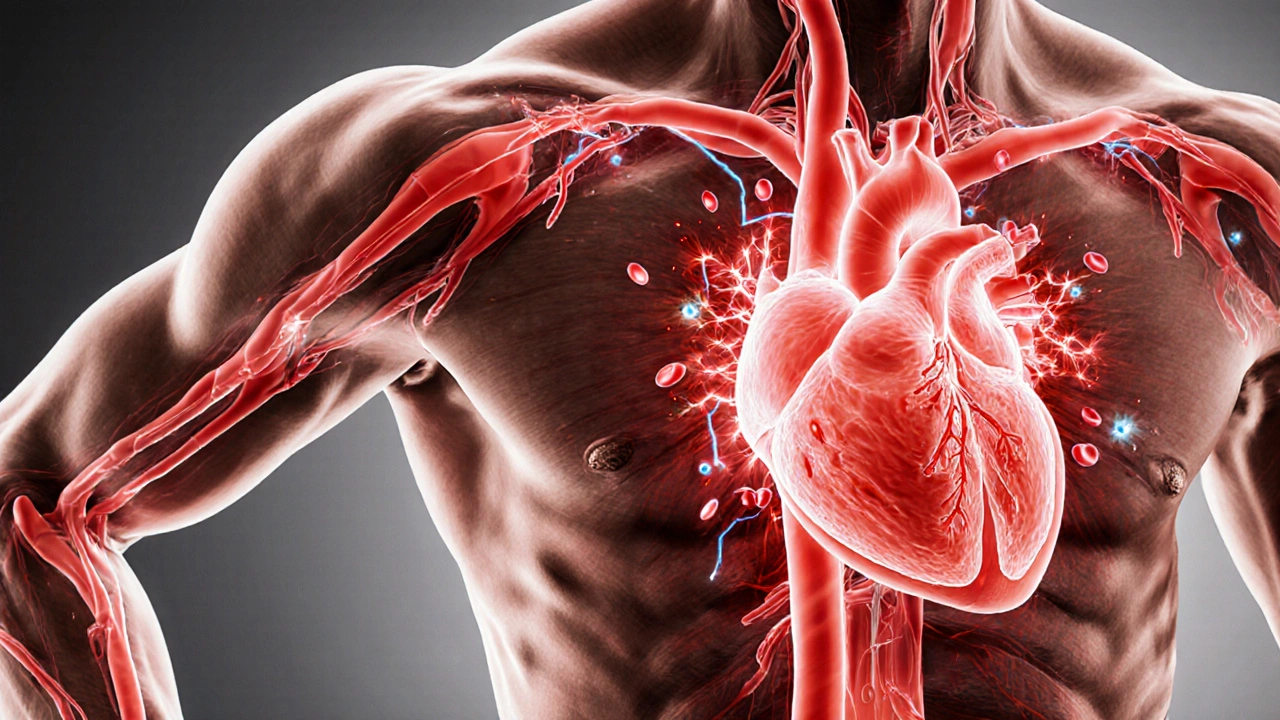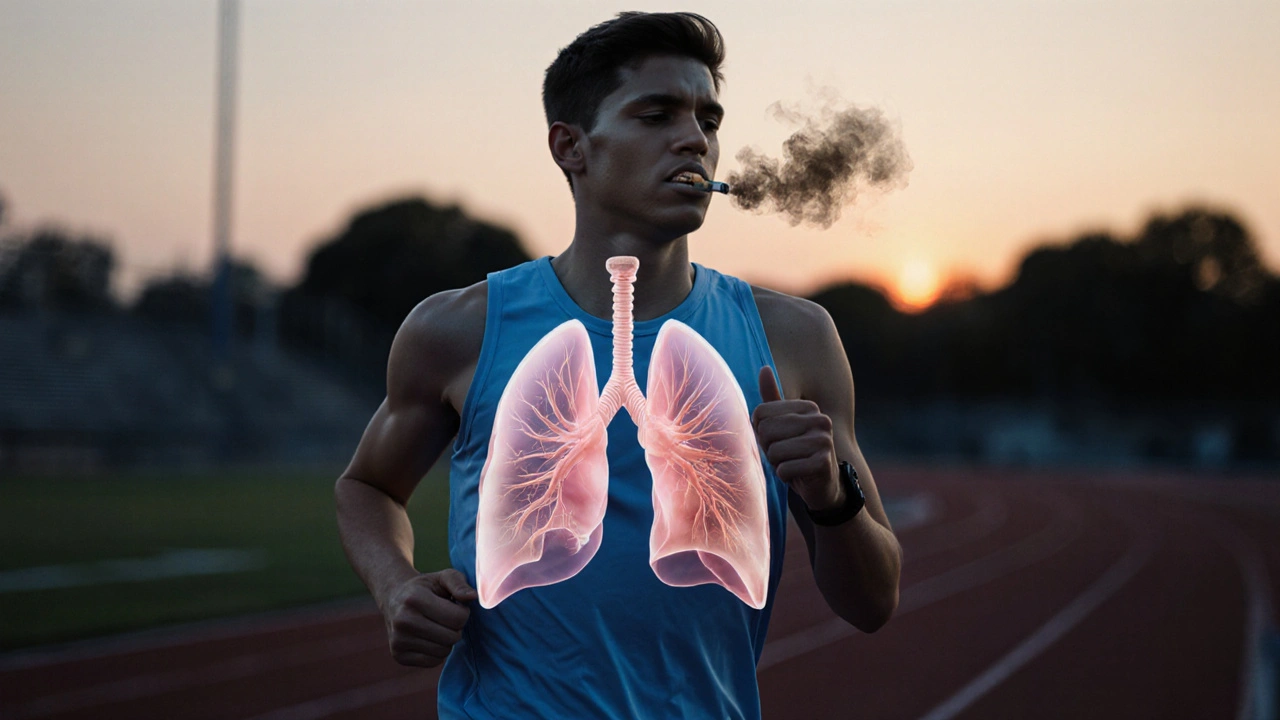Smoking Impact on Athletic Performance Calculator
Performance Impact Summary
Quick Takeaways
- Smoking reduces lung capacity and oxygen delivery, lowering endurance.
- Carbon monoxide from cigarettes cuts VO2 max by up to 15% in regular smokers.
- Heart rate and blood pressure spike during exercise, making workouts feel harder.
- Nicotine interferes with muscle recovery and raises metabolism, hindering strength gains.
- Quitting or cutting back can restore performance metrics within weeks.
Ever wonder why you struggle to hit that last sprint or why your bench press stalls despite solid training? The culprit may be more personal than you think. Smoking and athletic performance are tightly linked, and the chemicals you inhale can sabotage every fitness goal you set. Below we break down exactly how smoking messes with your body, show real data on endurance drops, and give you concrete steps to reclaim your peak.
When you light up, Smoking is a habit that forces thousands of toxins, such as nicotine and carbon monoxide, into the respiratory tract. Those toxins don’t just sit in your lungs; they travel through the bloodstream and hijack the systems you rely on for speed, strength, and stamina.
How Smoking Hits Your Respiratory System
The first place smoking hurts is the Lung Capacity is the total volume of air your lungs can hold and move during a breath. Each puff introduces irritants that inflame airway tissue, narrowing passages and reducing the amount of air you can draw in. Studies from the American Thoracic Society show that chronic smokers lose about 10% of lung capacity after ten years of regular use.
One of the sneakiest chemicals is Carbon Monoxide is a colorless, odorless gas that binds to hemoglobin more readily than oxygen. When CO occupies hemoglobin, less oxygen reaches muscles, meaning you tire faster and recover slower. A 2023 study measuring elite cyclists found that a single cigarette reduced their VO2 max-a key endurance metric-by roughly 12% within minutes.

Cardiovascular Fallout During Exercise
Beyond the lungs, smoking spikes your Heart Rate is the number of beats per minute, reflecting cardiac workload. Nicotine triggers adrenaline, which raises heart rate even at rest. During high‑intensity intervals, a smoker’s heart is already working harder, leaving fewer reserves for the actual workout.
Blood pressure follows suit. Blood Pressure measures the force of blood against artery walls, expressed as systolic over diastolic. Elevated pressure narrows arteries, limiting blood flow to active muscles. The result? You feel winded earlier and can’t sustain peak power.
Then there’s Oxygen Transport refers to the movement of oxygen from lungs to tissues via the bloodstream.. With CO occupying hemoglobin and nicotine tightening blood vessels, the efficiency of oxygen transport drops dramatically. In practice, this means a runner’s stride shortens and a weightlifter’s lifts feel heavier.
Metabolism, Muscle Recovery, and Nicotine’s Double‑Edged Sword
Nicotine isn’t just a stimulant; it’s a metabolic disruptor. It raises basal metabolic rate by up to 7%, which sounds good for calorie burn, but it also accelerates the breakdown of muscle protein during recovery. Over time, this hampers hypertrophy and strength gains.
Muscle Recovery is the process by which damaged fibers rebuild stronger after exercise. Smoking impairs blood flow and reduces the delivery of nutrients needed for repair. A 2022 randomized trial with recreational runners showed a 20% slower recovery of creatine kinase levels-a marker of muscle damage-in smokers versus non‑smokers.
Meanwhile, Metabolism encompasses all chemical reactions that provide energy to cells. The chronic inflammatory state induced by smoke creates oxidative stress, which depletes antioxidants and further damages cellular structures. This environment makes it harder for athletes to sustain training intensity across weeks.

Real‑World Data: VO2 Max and Endurance Loss
VO2 max-the maximum amount of oxygen your body can use during intense exercise-is the gold standard for aerobic performance. Below is a snapshot from a 2023 meta‑analysis that pooled data from 12 studies comparing smokers with non‑smokers.
| Group | Men | Women |
|---|---|---|
| Non‑Smokers | 55.2 | 48.7 |
| Light Smokers (≤5 cig/day) | 50.1 | 44.3 |
| Heavy Smokers (≥15 cig/day) | 44.8 | 38.9 |
Even a modest habit can shave five to ten points off VO2 max, translating to slower race times and reduced training capacity. The good news? After quitting, VO2 max can rebound by 5‑10% within three months, especially if you double down on cardio work.
Practical Steps for Athletes Who Smoke
- Track Baseline Metrics: Use a simple field test (e.g., 1‑mile run) to record time, heart rate, and perceived exertion.
- Set a Quit Timeline: Aim for a realistic reduction-cut back by one cigarette every three days, then switch to nicotine patches if needed.
- Incorporate Breath‑Training: Techniques like diaphragmatic breathing and interval hypoxic training can improve lung efficiency while you quit.
- Prioritize Recovery Nutrition: Antioxidant‑rich foods (berries, leafy greens) counteract smoke‑induced oxidative stress.
- Monitor Heart Rate Variability (HRV): A drop in HRV often signals lingering nicotine effects; adjust training load accordingly.
- Re‑test Every 4‑6 Weeks: Watch VO2 max, sprint times, and strength numbers climb as smoke clears.
Remember, the body is surprisingly resilient. Even if you’ve been smoking for years, a focused quit plan paired with smart training can unlock performance you thought was lost.
Frequently Asked Questions
Does occasional smoking still hurt my workouts?
Yes. Even a single cigarette introduces carbon monoxide that temporarily reduces oxygen carrying capacity, making that day’s session feel tougher. Regular occasional use can add up, leading to chronic declines in endurance.
How quickly does VO2 max improve after quitting?
Most studies report noticeable gains within 4-12 weeks, with plateaus around the 6‑month mark as the lungs recover and blood oxygen levels normalize.
Can nicotine replacement therapy (NRT) still affect performance?
NRT delivers nicotine without carbon monoxide, so the oxygen transport issue diminishes. However, nicotine alone still raises heart rate and can interfere with muscle recovery, so athletes should use the lowest effective dose.
Is vaping any better for athletic performance?
Vaping eliminates many combustion by‑products, but still delivers nicotine and often other chemicals that can reduce lung elasticity and impair VO2 max. The performance gap isn’t fully closed.
What signs tell me my body is still suffering from smoking?
Persistent shortness of breath, elevated resting heart rate, slower recovery after hard intervals, and a consistently low HRV are red flags that residual smoke effects remain.



17 Comments
Dylan Hilton October 6, 2025 AT 16:39
Wow, this article really breaks down how smoking messes with your workouts! I love how it spells out the VO₂ max drop and the heart‑rate spike – makes the science feel real. If you’re trying to hit a PR, cutting back on cigarettes is basically a shortcut to better gains. Keep tracking those numbers and you’ll see the difference in just a few weeks. Stay motivated and keep breathing easy!
Christian Andrabado October 10, 2025 AT 03:09
Smoking cuts oxygen delivery. Your VO2 max drops an average of 12% after a single cigarette. Heart rate stays elevated during exercise. That’s why the cardio feels harder.
Chidi Anslem October 13, 2025 AT 13:39
It is fascinating to contemplate the relationship between habit and physiology, especially when the habit involves inhaling toxins. The respiratory system, designed to exchange gases efficiently, is forced to operate under suboptimal conditions when carbon monoxide binds hemoglobin. This binding reduces the oxygen‑carrying capacity of the blood, a fact that has been demonstrated in elite cyclists who experience a measurable dip in performance after smoking. Moreover, the chronic inflammation induced by tobacco smoke creates oxidative stress that extends beyond the lungs, affecting muscle repair mechanisms. From a philosophical standpoint, one might view smoking as a self‑inflicted limitation, a paradox where the desire for immediate gratification undermines long‑term capabilities. The data presented in the article, such as the 10 % lung‑capacity loss after a decade of smoking, underscores the cumulative nature of these harms. It also aligns with the broader literature on how lifestyle choices shape physiological potential. In practice, athletes who reduce or quit smoking often report a resurgence of stamina within weeks, suggesting that the body retains a remarkable capacity for recovery. This resilience can be attributed to the plasticity of the cardiovascular system, which can improve endothelial function once the irritants are removed. The article’s recommendation to incorporate breath‑training and antioxidant‑rich foods serves as a practical bridge between theory and application. While nicotine replacement therapy eliminates carbon monoxide, it does not fully erase the sympathetic stimulation that raises heart rate, so even nicotine alone can be a performance limiter. The nuanced discussion of heart‑rate variability as a biomarker for lingering nicotine effects offers a useful monitoring tool for athletes. Ultimately, the interplay between smoking and performance is a clear illustration of how external substances can modulate internal homeostasis. By understanding these mechanisms, athletes can make informed decisions that align with their performance goals. The key takeaway is that quitting is not merely a health decision but a strategic move to reclaim athletic potential.
Penn Shade October 17, 2025 AT 00:09
While the numbers you presented are directionally correct, the article actually cites a 12 % VO₂ max reduction after a single cigarette in elite cyclists, not a blanket 12 % for all athletes. Additionally, heart‑rate elevation can vary based on baseline fitness; a trained runner might see a 5‑10 % increase rather than the flat figure you implied. It's important to contextualize these metrics within the broader physiological response.
Holly Hayes October 20, 2025 AT 10:39
its just plain selfish to keep lighting up when you know it wrecks your body and the planet. smoking ain't just a personal choice, it's a public health disaster and a massive waste of potential. if you care about your own goals, quit now.
Stephen Gachie October 23, 2025 AT 21:09
While the moral urgency is clear, it's also useful to avoid blanket statements that might alienate smokers seeking help. The physiological data shows that quitting improves performance, so framing the message in terms of personal benefit can be more effective.
Jennifer Banash October 27, 2025 AT 07:39
Esteemed readers, one must confront the stark reality presented within these pages: tobacco consumption is not merely a trivial vice, but a formidable adversary to athletic aspiration. The insidious infiltration of carbon monoxide, nicotine, and a myriad of deleterious compounds into the circulatory system precipitates a cascade of physiological perturbations, each meticulously documented herein. Firstly, the diminution of hemoglobin's oxygen‑binding capacity curtails aerobic metabolism, thereby eroding the very foundation of endurance performance. Secondly, the chronic elevation of sympathetic tone, induced by nicotine, imposes an untoward tachycardia that compromises cardiac efficiency during high‑intensity exertion. Thirdly, the progressive loss of alveolar elasticity engenders a measurable decline in vital capacity, a fact corroborated by the cited ten‑percent decrement after a decade of habitual smoking. Moreover, the inflammatory milieu fostered by tobacco smoke impedes myogenic repair, attenuating hypertrophic signaling pathways essential for strength gains. It is noteworthy that the article furnishes empirical evidence demonstrating a 5‑10 % rebound in VO₂ max within merely three months of cessation, a testament to the body's resilient capacity for recovery. The recommended interventions-ranging from diaphragmatic breathing exercises to antioxidant‑rich nutrition-serve not merely as ancillary suggestions but as integral components of a comprehensive rehabilitation protocol. In light of these considerations, the prudent course of action for any athlete, whether novice or seasoned, is unequivocal: to abandon the habit that so flagrantly undermines physiological potential. Let this exposition serve as both a clarion call and an actionable roadmap, guiding you toward the reclamation of optimal performance. May your journey be marked by perseverance, informed choice, and the ultimate triumph over self‑imposed limitation.
Sara Spitzer October 30, 2025 AT 18:09
Again, you dramatize a well‑known fact. The data is already out there; no need for theatrical flair.
Jennifer Pavlik November 3, 2025 AT 04:39
Quitting smoking can feel tough, but every small step counts. Try cutting back a little each week and celebrate the gains you notice in your workouts. You’ll be surprised how quickly your breathing improves and your stamina climbs.
Jacob Miller November 6, 2025 AT 15:09
Sure, you can keep smoking and blame the lack of progress on “genetics,” but the facts in the article are pretty clear. It’s not a conspiracy, just chemistry.
Terry Duke November 10, 2025 AT 01:39
Honestly, Jacob, it’s encouraging that you’re even engaging with the science, however, consider that reducing cigarettes can lead to measurable improvements, for example, a lower resting heart rate, better lung function, and faster recovery times, all of which contribute positively to performance.
Anshul Gandhi November 13, 2025 AT 12:09
Don’t be fooled by mainstream fitness advice – the tobacco industry funds the very studies that downplay long‑term damage, and the “quick fixes” they sell are just a way to keep you hooked while they profit.
Emily Wang November 16, 2025 AT 22:39
Take this as a challenge: ditch the cigarettes, track your VO₂ max, and watch your times drop. You’ve got the power to rewrite your own performance story.
Hayden Kuhtze November 20, 2025 AT 09:09
Oh great, another article telling us that smoking is bad for cardio – who could have guessed?
Craig Hoffman November 23, 2025 AT 19:39
Hey folks, if you’re looking to cut back, try swapping a cigarette for a quick walk or a set of jumping jacks. It keeps your heart busy and helps break the habit loop. Also, staying hydrated can reduce cravings, so keep a water bottle handy during workouts.
Chester Bennett November 27, 2025 AT 06:09
Exactly, Craig. Adding short bursts of cardio between sets not only distracts from nicotine cravings but also boosts your overall conditioning. Consistent practice will make the transition smoother.
Emma French November 30, 2025 AT 16:39
Quit smoking and watch your performance soar.